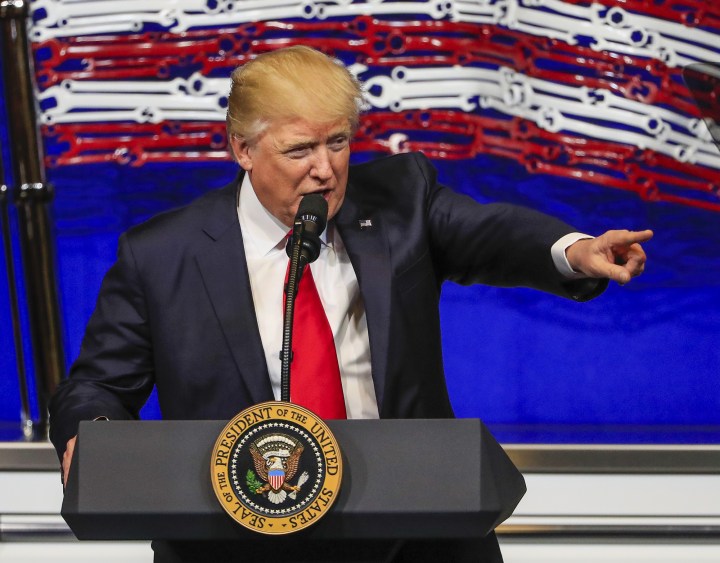STATE OF AMERICA: ANALYSIS
Trump crusades through Kenosha, giving millions of dollars to law enforcement

Visiting Kenosha, the scene of recent protests where a white police officer shot an unarmed black man in the back at close range, leaving him paralysed, Donald Trump praised law enforcement. He also “inspected” buildings damaged by protest action and urged empathy for police officers who “choke”, while completely ignoring the man who was shot by police.
On Tuesday, 1 September, Donald Trump was in Jacob Blake’s backyard, as the saying goes, but did not bother to visit him or his family. Since the announcement that the American president intended to visit Kenosha, the big question had been whether he would see Blake or meet his family. The response was obfuscatory and consistent – the official version of “crickets”: The schedule has not been ironed out yet.
It’s unclear if 29-year-old Blake will ever walk again. He was shot in the back by a white police officer just over a week ago on 23 August 2020. Later that night, protestors were at the courthouse, which sustained some damage when the protest turned into unrest after police fired teargas at the crowd. The next day saw a second night of protests and parts of Kenosha ablaze when multiple buildings were set on fire. Local media reported that it was, however, unclear how the fires had started. Since the shooting of Blake, Kenosha has been the site of daily protest marches.
On 25 August, a 17-year-old white male shot and killed two protestors and wounded a third. The teen, Kyle Rittenhouse, is being charged as an adult – there are at least six charges against him, including two counts of first degree homicide. He is also charged with reckless endangerment, among other charges.
The day before his visit to Kenosha, at a briefing at the White House on 31 August, Trump said his supporters were peaceful – Rittenhouse is a known Trump supporter. The US president said: “He was trying to get away from them, I guess, it looks like and then he fell and they very violently attacked him.” He was referring to footage showing the teen running and falling, and someone trying to grab the rifle he is holding. The same video shows prior to him falling, people are shouting “he shot someone” and there is a body lying in the street. There is also a video of the teenager on his cellphone near the body, saying “I think I killed someone”.
Trump visited damaged buildings and spoke to law enforcement officials, and Kenosha community members whose buildings and businesses had been damaged by some of the unrest around the protests. No mention was made of the shooting of a black man by a white police officer – the event which set the protests in motion.
While Trump was looking at buildings, speaking to law enforcement and small business owners, which led to a community safety roundtable, Blake’s family and many Kenosha residents were holding a peaceful community gathering at the place where Blake had been shot, in celebration of the community and their spirit. Reverend Jesse Jackson was also present.
Speaking at the community safety roundtable in Kenosha, Trump congratulated the National Guard and local law enforcement on “acting swiftly”, and called protestors domestic terrorists: “Violent mobs demolished or damaged at least 25 businesses, burned down public buildings and threw bricks at police officers… these are not acts of peaceful protest but really domestic terror…”
He said the National Guard should be called out to every city that experienced protests – he named Portland, Oregon, where Trump supporters deliberately and aggressively inserted themselves into a protest march on 29 August, and where later that night, a man was shot and killed – as Trump believed the National Guard would decisively quell any protests. “It would all be over very, very quickly.”
Trump lavished praise on law enforcement officers and seemed to say there should be no repercussions if they make a “mistake”: “We have to give our law enforcement additional support… These are great people… We have to be thankful that we have them… We can’t be threatening them, they’ll be living a bad life if they utter a bad word. You can’t do it.”
He also criticised Joe Biden, and those calling for police and law enforcement to be held accountable for racist and violent behaviour saying: “To stop the political violence, we must also confront the radical ideology that includes this violence. Reckless far left politicians continue to push the destructive message that our nation and our law enforcement are oppressive or racist.”
The closest the US president came to mentioning the killing of the black man, which had set off the actions leading up to his presence in Kenosha, was when he seemed to excuse the officer who had shot Blake: “You have people that choke!”
“We have to condemn the dangerous anti-police rhetoric, it’s getting more and more, it’s very unfair. You have some bad apples, we all know that, and those will be taken care of through the system… And you have people that choke… They’re under tremendous pressure… all of a sudden they’re faced with a decision… and if they make a wrong decision one way or the other, they’re either dead or they’re in big trouble… and they choke sometimes and it’s a very tough situation… then people call them bad and horrible.”
Trump’s administration is also giving money to Wisconsin: $4-million to small businesses impacted by protest actions and over $42-million to public safety, including direct support to law enforcement.
This is politics. Wisconsin is a critical state – with 10 electoral votes, a presidential candidate needs 270 to gain a majority, meaning, to win. Trump has presented himself as tough on crime, chasing a second term in office with the theme of “Law and Order”, often tweeting it – sometimes in all caps.
LAW & ORDER!
— Donald J. Trump (@realDonaldTrump) May 31, 2020
The US president has created an “us and them” scenario, and is set on driving a wedge right into the heart of America, hoping to corral most Americans onto his side of the fence with himself and all “law-abiding” Americans in the “us” category as the good guys – who by virtue of being good and therefore law abiding, have to be supporters of law enforcement. The protestors are therefore “them”, and are being called “domestic terrorists” promoting acts and engaging in acts of “domestic terror”, “anarchists” and “killers”. “They” want to defund the police.
This is an act of linguistic prestidigitation where language is used to say one thing, but is laced with multiple meanings and nuances – that Trump is not racist, that he loves America and law-abiding Americans, and that he (therefore) respects law enforcement and any American who loves their country and personal safety would feel the same. What he means is protestors who started off as overwhelmingly African Americans protesting police violence against black US citizens, and were among the first voices to call for defunding the police, are not law abiding. And that white people who join them in this are anti-American and disrespectful of law enforcement, and this grouping as a whole is therefore a threat to safety and the American way of life.
The avoidance of the issue of black lives being under threat from the police, of the fact that black men are getting shot and being paralysed by white police officers, means the elephant in the room – systemic racism – is ignored while he uses the situation to polarise Americans and convince them of the “Swart Gevaar”/”domestic terror” so that they end up in his camp.
Because it’s not that Black Lives do not Matter to Trump, it is just that America matters more. In July 2020, he tweeted that New York was “denigrating” Fifth Avenue by painting a Black Lives Matter sign on it – which he said would also “further antagonize New York’s Finest”.
NYC is cutting Police $’s by ONE BILLION DOLLARS, and yet the @NYCMayor is going to paint a big, expensive, yellow Black Lives Matter sign on Fifth Avenue, denigrating this luxury Avenue. This will further antagonize New York’s Finest, who LOVE New York & vividly remember the….
— Donald J. Trump (@realDonaldTrump) July 1, 2020
He followed up with a second tweet, calling the Black Lives Matter sign a symbol of hate.
….horrible BLM chant, “Pigs In A Blanket, Fry ‘Em Like Bacon”. Maybe our GREAT Police, who have been neutralized and scorned by a mayor who hates & disrespects them, won’t let this symbol of hate be affixed to New York’s greatest street. Spend this money fighting crime instead!
— Donald J. Trump (@realDonaldTrump) July 1, 2020
Trump’s behaviour is reminiscent of how Richard Nixon in 1968 could not use the N-word after the passing of various civil rights bills ending legal segregation some three to four years earlier, but he found ways to allude to it. South Africans will remember the politics of fear at the heart of the “Swart Gevaar” – take a moment to consider that the US has a population of 330 million, of which under 15% is African American. Nixon also ran a campaign promising to restore law and order and like Trump, Nixon also needed to attract more voters. Enter Southern Strategy, which is possibly best explained by legendary campaign consultant Lee Atwater, who worked on Nixon’s campaign.
Atwater famously explained Southern Strategy in a 1981 interview as the art of getting racists to vote for you without yourself coming across as racist: “You start out in 1954 by saying ‘N…, N…, N…,’ by 1968 you can’t say ‘N…,’ – that hurts you, backfires. So you say stuff like, uh forced busing, state’s rights, and all that stuff, and you’re getting so abstract. Now you’re talking about cutting taxes, and all these things you’re talking about are totally economic things and a byproduct of them is, blacks get hurt more than whites…” DM
An Wentzel is Night Editor, specialist reporter for Daily Maverick, she went to the USA to visit family as the pandemic struck and is currently marooned in the land of the ‘free’.



















 Become an Insider
Become an Insider